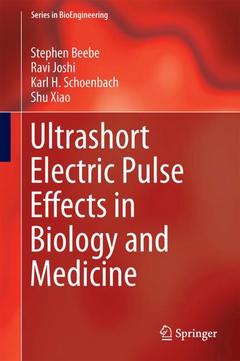Description
Ultrashort Electric Pulse Effects in Biology and Medicine, 1st ed. 2021
Series in BioEngineering Series
Language: English
Subjects for Ultrashort Electric Pulse Effects in Biology and Medicine:
451 p. · 15.5x23.5 cm · Hardback
Description
/li>Contents
/li>Biography
/li>Comment
/li>
This book presents an overview of the current state of research on ultrashort electric field pulses of high intensity and their use in biology and medicine. It examines in detail the most recent and exciting advances in how nanosecond and picosecond electric pulse research has grown and expanded into new areas of biology and medicine.
Further, the book specifically focuses on electric pulses in the time domain, on intracellular effects as opposed to plasma membrane electroporation, and highlights the biological and medical applications of these unique pulse effects. Since the authors were initial innovators exploring nanosecond and picosecond pulses, their unique perspectives foreshadowed directions the research took, expanding into new areas that they continue to investigate today.
Stephen J. Beebe studied Zoology at Ohio University, Athens. He then served as a Peace Corps Volunteer in the British West Indies (1973–1975) teaching biology, working on soil and water conservation with 4H and diagnostic biochemistry and analysing the nutritional status of preschool children at Queen Elizabeth Hospital. As a PhD student, he purified and characterized cAMP-independent protein kinases involved in glycogen metabolism. As a Post-Doctoral Fellow and Research Associate at the HowardHughes Medical Institute (HHMI) in Vanderbilt, he defined the roles for cAMP-dependent protein kinases (PKAs) and cAMP phosphodiesterases in regulating glycogen and lipid metabolism, insulin action, gene transcription and granulosa cell differentiation.
As a Fulbright and Marshal Scholar in Oslo, he cloned three catalytic subunits of PKA from a human testes library. He subsequently returned to the USA, serving as an Assistant Professor at the Jones Institute for Reproductive Medicine, where he showed that apoptosis markers in sperm could be used as markers for sperm quality. He also established procedures leading to successful pre-embryo genetic diagnosis and prevention of Tay–Sachs disease. Remaining at the Eastern Virginia Schools of Medicine (EVMS), but moving to the Departments of Pediatrics and Physiological Sciences, he defined structure–function relationships of PKA catalytic subunits and established roles for PKA to delay apoptosis in human neutrophils.
While at EVMS and since moving to Old Dominion University (ODU), over the last two decades he has demonstrated the effects and mechanisms of action of nanosecond pulsed electric fields (nsPEFs) on biological cell structures and function as a means of modulating signal transduction and ablating cancer. He is now investigating nsPEF ablation-induced immune responses in rat liver and mouse mammary cancer. As one of the leading pioneers developing uses for nsPEFs on biological cell
Extensively examines the most recent and exciting advances in how nanosecond and picosecond electric pulse research has grown and expanded into new areas of biology and medicine
Focuses on intracellular effects as opposed to plasma membrane electroporation
Highlights the biological and medical applications of these unique pulse effects

